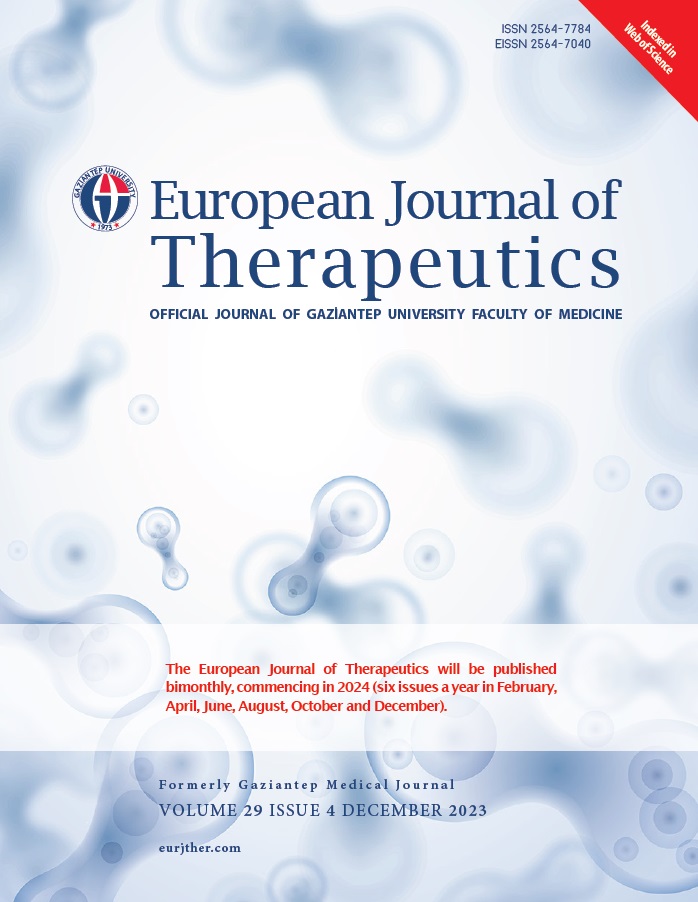In-vitro Diagnosis of Approximal Caries in Teeth Periapical Radiography with Different Exposure Parameters
DOI:
https://doi.org/10.58600/eurjther1900Keywords:
Aproximal Caries, Periapical Radiography, Photo-stimulated Phosphor PlateAbstract
Objective: The aim of this study was to evaluate periapical radiographs of enamel caries, dentin caries, and deep caries with exposed pulp and intact teeth obtained in vitro using photo-stimulated phosphor plates (PSP) under different exposure parameters.
Methods: 3 non-carious extracted molars were selected. The obtained molars were embedded in the wax created from pink wax by ensuring approximal contact and a base was created. 14 different imaging protocols were used with 60 kVp, 4 mA 0.02-0.1 second and 70 kVp 7 mA, 0.25-1.25 second exposure parameters. Intact teeth were imaged with these various imaging protocols. Artificial cavities were then created for enamel caries, dentin caries and deep caries with exposed pulp and imaged according to the same protocols. The images were evaluated by 3 clinicians who were blind to the exposure protocol and caries status. Inter-observer agreement with actual situations was examined with Kappa statistics.
Results: In the low-dose group, the kappa values of observer 1, observer 2, and observer 3 were 0.905, 0.952, 0.952, respectively. The kappa values of observer 1, observer 2, and observer 3 in the ultralow-dose group were 0.833, 1, 1, and the kappa values of observer 1, observer 2, and observer 3 in the high-dose group were 1, 1, 0.833, respectively. The results obtained in all groups showed a statistically significant-excellent agreement (p<0.001).
Conclusion: Approximal caries can be diagnosed with intraoral radiography obtained with low radiation doses with PSP in dentistry. Thus, patients could be exposed to less ionizing radiation.
Metrics
References
Pereira A, Verdonschot E, Huysmans M (2001) Caries detection methods: can they aid decision making for invasive sealant treatment? Caries Res. 35:83-89. https://doi.org/10.1159/000047437
Şenel B, Kamburoğlu K, Üçok Ö, Yüksel S, Özen T, Avsever H (2010) Diagnostic accuracy of different imaging modalities in detection of proximal caries. Dentomaxillofac Radiol. 39:501-511. https://doi.org/10.1259/dmfr/28628723
Kamburoğlu K, Kolsuz E, Murat S, Yüksel S, Özen T (2012) Proximal caries detection accuracy using intraoral bitewing radiography, extraoral bitewing radiography and panoramic radiography. Dentomaxillofacial Radiol. 41:450-459. https://doi.org/10.1259/dmfr/30526171
Koraltan M. Arayüz çürüklerinin tespit edilmesinde kullanılan radyografik yöntemlerin sensitivite ve spesifitesinin değerlendirilmesi. https://acikbilim.yok.gov.tr/handle/20.500.12812/599312
White SC, Pharoah MJ (2018) White and Pharoah's Oral Radiology: Principles and Interpretation. 7th/Edition. Elsevier Inc, New York, USA.
Kurt H, Nalçacı R (2016) Intraoral Digital Imaging Systems: Direct Digital Imaging, CCD, CMOS, Flat Panel Detectors, Indirect Digital Imaging, Semi-direct Digital Imaging, Phosphor Plate Scanning. Turkiye Klinikleri J Oral Maxillofac Radiol-Special Topics. 2:4-9.
Pontual A, De Melo D, De Almeida S, Bóscolo F, Haiter Neto F (2010) Comparison of digital systems and conventional dental film for the detection of approximal enamel caries. Dentomaxillofacial Radiol. 39:431-436. https://doi.org/10.1259/dmfr/94985823
van der Stelt PF (2008) Better imaging: the advantages of digital radiography. J Am Dent Assoc. 139:7-13. https://doi.org/10.14219/jada.archive.2008.0357
Wenzel A (2014) A review of dentists' use of digital radiography and caries diagnosis with digital systems. Dentomaxillofacial Radiol. 35:5:307-314. https://doi.org/10.1259/dmfr/64693712
Van Der Stelt PF (2005) Filmless imaging: the uses of digital radiography in dental practice. J Am Dent Assoc. 136:1379-1387. https://doi.org/10.14219/jada.archive.2005.0051
Soğur E, Güniz Baksi B (2011) Intraoral Digital Imaging Systems. Atatürk Üniversitesi Diş Hek Fak Derg. 2011(3):249-254.
Vandenberghe B, Jacobs R, Bosmans H (2010) Modern dental imaging: a review of the current technology and clinical applications in dental practice. Eur Radiol. 20(11):2637-2655. https://doi.org/10.1007/s00330-010-1836-1
Shore RE, Beck HL, Boice Jr JD, Caffrey EA, Davis S, Grogan HA, Mettler Jr FA, Preston RJ, Till JE, Wakeford R (2019) Recent epidemiologic studies and the linear no-threshold model for radiation protection—considerations regarding NCRP commentary 27. Health Phys. 116(2):235-246. https://doi.org/1097/HP.0000000000001015
Schüler IM, Hennig CL, Buschek R, Scherbaum R, Jacobs C, Scheithauer M, Mentzel HJ (2023) Radiation Exposure and Frequency of Dental, Bitewing and Occlusal Radiographs in Children and Adolescents. J Pers Med. 13(4):692. https://doi.org/10.3390/jpm13040692
Abesi F, Mirshekar A, Moudi E, Seyedmajidi M, Haghanifar S, Haghighat N, Bijani A (2012) Diagnostic accuracy of digital and conventional radiography in the detection of non-cavitated approximal dental caries. Iran J Radiol. 9(1):17-21. https://doi.org/10.5812/iranjradiol.6747
Sogur E, Baksı BG, Orhan K, Paksoy SC, Dogan S, Erdal YS, Mert A (2011) Effect of tube potential and image receptor on the detection of natural proximal caries in primary teeth. Clin Oral Investig. 15:901-907. https://doi.org/10.1007/s00784-010-0461-3
Dehghani M, Barzegari R, Tabatabai H, Ghanea S (2017) Diagnostic value of conventional and digital radiography for detection of cavitated and non-cavitated proximal caries. J Dent (Tehran). 14(1):21-30.
De Melo DP, Cruz AD, Melo SLS, De Farias JFG, Haiter-Neto F, De Almeida SM (2015) Effect of different tube potential settings on caries detection using psp plate and conventional film. J Clin Diag Res. 9(4):ZC58-Z61. https://doi.org/10.7860/JCDR/2015/12225.5845
Huda W, Abrahams RB (2015) Radiographic techniques, contrast, and noise in x-ray imaging. Am J Roentgenol. 204(2):126-131. https://doi.org/10.2214/AJR.14.13116
Wenzel A, Møystad A (2001) Experience of Norwegian general dental practitioners with solid state and storage phosphor detectors. Dentomaxillofac Radiol. 30(4):203-208. https://doi.org/10.1038/sj.dmfr.4600613
Hellén-Halme K, Nilsson M (2013) The effects on absorbed dose distribution in intraoral X-ray imaging when using tube voltages of 60 and 70 kV for bitewing imaging. J Oral Maxillofac Res. 4(3):e2. https://doi.org/10.5037/jomr.2013.4302
Downloads
Published
How to Cite
License
Copyright (c) 2023 European Journal of Therapeutics

This work is licensed under a Creative Commons Attribution-NonCommercial 4.0 International License.
The content of this journal is licensed under a Creative Commons Attribution-NonCommercial 4.0 International License.
Funding data
-
Inönü Üniversitesi
Grant numbers project # TSG-2021-2774


















